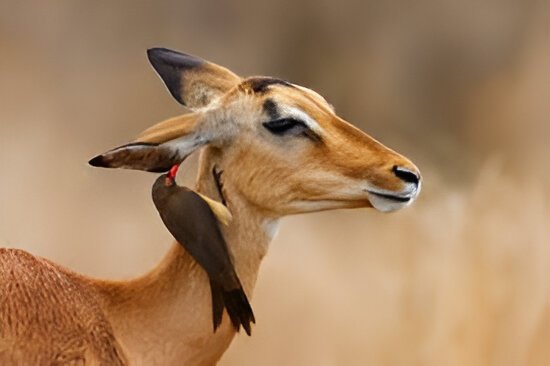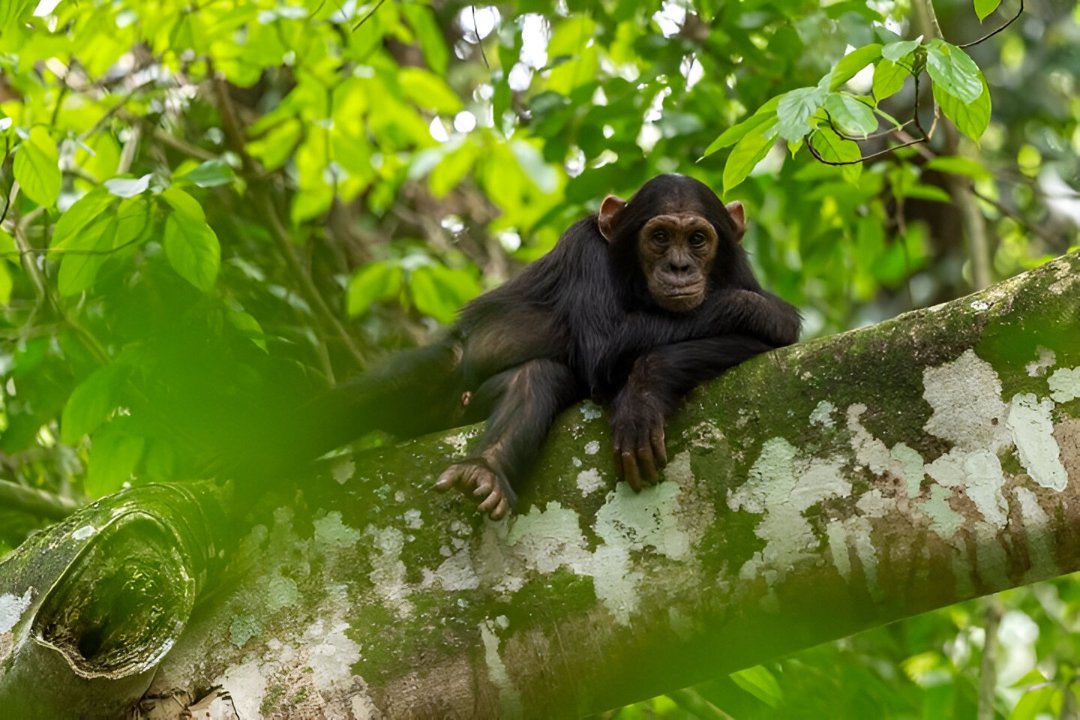Animals You Can Only See in Uganda.
Uganda is often called the “Pearl of Africa”, and one of its greatest treasures is its wildlife. This country’s compact size encompasses Congo Basin rainforests, savannahs, far-reaching wetlands, and volcanic mountains — creating habitat diversity that supports rare and endemic species found nowhere else. In this guide, we’ll explore the most fascinating animals unique to Uganda, explain what makes them special, and tell you where to go to encounter them responsibly.
1. Mountain Gorilla (Gorilla beringei beringei)
- Why Unique: One of only three wild populations, with ~1,063 individuals across Uganda, Rwanda, and Congo
- Where to See: Bwindi Impenetrable and Mgahinga National Parks.
- Special Experience: Gorilla trekking is a life-changing experience — face-to-face encounters in misty forest canyons, equipped with knowledge of conservationists like Dian Fossey
2. Golden Monkey (Cercopithecus kandti)
- Why Unique: Only found in the Albertine Rift — especially in Uganda’s Mgahinga NP; population ~3,000 .
- Where to See: Mgahinga Gorilla NP.
- Special Experience: Golden-orange fur, playful troops bounding through bamboo forests — a fast-paced, colorful delight.
3. Uganda Mangabey (Lophocebus albigena ugandae)
- Why Unique: A vulnerable subspecies found only in Ugandan forests (Mabira, Kibale)
- Where to See: Mabira Forest, Kibale FR.
- Special Experience: Look for their social groups in the canopy — alert, vocal, and rare sightings in ethereal forest settings.
4. Ugandan Red Colobus (Piliocolobus tephrosceles)
- Why Unique: Endemic primate found only in Kibale; population ~17,000 in Uganda
- Where to See: Kibale National Park.
- Special Experience: Their striking red-orange fur and troop behavior make sightings unforgettable — often seen leaping among forest treetops.
5. Ruwenzori Colobus (Colobus angolensis ruwenzorii)
- Why Unique: A subspecies of Angola colobus, native to Rwenzori Mountains and their foothills
- Where to See: Rwenzori National Park, Mount Elgon.
- Special Experience: Watch large troops flap white-furred mantles through alpine forests — a living spectacle.
6. Shoebill (Balaeniceps rex)
- Why Unique: Iconic prehistoric-looking bird endemic to Central African swamps; relatively accessible in Uganda
- Where to See: Mabamba Swamp, Murchison Falls, Semuliki NP.
- Special Experience: Boating within meters of these still, imposing birds — a walking-in-time-back machine.
7. Rothschild’s Giraffe (Giraffa camelopardalis rothschildi)
- Why Unique: Taller and rarer; ~1,700 in the wild, with most in Uganda
- Where to See: Murchison Falls, Lake Mburo.
- Special Experience: Magnificent long-necked elegance in savannah light, often gathered in small family groups.
8. Uganda Kob (Kobus kob thomasi)
- Why Unique: National animal of Uganda, seen across savannahs in large leks
- Where to See: Murchison Falls, Queen Elizabeth NP.
- Special Experience: Large herds in open plains; during mating, males whistle and display to compete for females.
9. Shoebill (Balaeniceps rex)
(Also listed above – combine repetition? We cover it once.)
10. Sitatunga (Tragelaphus spekii)
- Why Unique: Semi-aquatic antelope adapted to swampy papyrus lands; elusive
- Where to See: Semuliki NP, Mabamba Swamp.
- Special Experience: Stealthy trekking with rangers in swamp canoes — perfect for rare sightings and haunting photographs.
11. Nile Crocodile (Crocodylus niloticus)
- Why Unique: One of the largest freshwater predators; widespread in lakes and rivers.
- Where to See: Kazinga Channel, Nile, Lake Mburo.
- Special Experience: Riverboat safaris along the Kazinga Channel offer breath-taking close views — often side-by-side with hippos
12. African Forest Elephant (Loxodonta cyclotis)
- Why Unique: Smaller than Savannah elephants, demanding dense forest habitat .
- Where to See: Semuliki, Kibale, Bwindi.
- Special Experience: Rare sightings of foraging elephants patrolling dense forests — magical and humbling.
13. Pangolin (Manis spp.)
- Why Unique: One of the world’s most trafficked animals; conservation priority
- Where to See: Kibale, Semuliki, Mgahinga (tracking via conservation networks).
- Special Experience: Nighttrek possibility to glimpse these nocturnal, scaly diggers.
14. African Golden Cat (Caracal aurata)
- Why Unique: Rainforest-dwelling feline native to the Congo basin .
- Where to See: Kibale, Bwindi, Semuliki.
- Special Experience: Extreme rarity — best spotted via motion-triggered cameras or lucky forest walks.
15. Giant Forest Hog (Hylochoerus meinertzhageni)
- Why Unique: Largest wild pig species, only in forested Africa .
- Where to See: Kibale, Queen Elizabeth, Semuliki.
- Special Experience: Massive tusked hogs shuffling through forest — sign of intact ecosystems.
16. Uganda Clawed Frog (Xenopus ruwenzoriensis)
- Why Unique: Endemic to Ugandan freshwater habitats, with rare 12 chromosome sets (dodecaploid)
- Where to See: Forest streams in Rwenzori/Mabira.
- Special Experience: Herping on wet forest nights — witness amphibian evolution in motion.
17. Three-Horned Chameleon (Trioceros johnstoni)
- Why Unique: Rare horned chameleon native to Rwenzori forests .
- Where to See: Rwenzori, high-altitude forest trails.
- Special Experience: Camouflaged pachyderm-like creatures perched in forest — elusive and magical.
18. Fox’s Weaver (Ploceus spekeoides)
- Why Unique: Endemic bird to Uganda .
- Where to See: Riverine habitats, especially in floodplains.
- Special Experience: Spot through binoculars as they flit and weaver nests shimmer in reeds at sunset.
19. Sese Island Sitatunga (Tragelaphus spekii subspecies)
- Why Unique: Possibly endemic antelope to Ssese Islands .
- Where to See: Ssese Islands, Lake Victoria.
- Special Experience: Rare swamp-adapted antelopes hiding in island reeds — a photographic gem.
20. Rwenzori Shaggy Rat & Other Lesser-Known Endemics
- Why Unique: Rare rodents, frogs, and fish found only in Uganda’s Albertine rift and lake systems .
- Where to See: Rwenzori, freshwater marshes.
- Special Experience: Biospecies hikes with specialist guides — for serious wildlife nerds.
Why Uganda Is a Biodiversity Treasure
- Primate paradise: ~20 species of monkeys, apes, gorillas, chimps – more than any African country.
- Over 1,000 bird species, including storks, pelicans, raptors, and Albertine Rift endemics.
- Rich range of reptiles and amphibians — evidence of ancient habitats and changeable ecosystems.
Uganda’s conservation success is notable: mountain gorilla numbers rose from ~680 to 1,063 in 30 years , and white rhino are being reintroduced via the Ziwa Sanctuary
FAQs: Seeing Uganda’s Unique Wildlife
Q: Which animal is easiest to spot?
The grey-crowned crane (national bird), Uganda kob, and hippos are widespread and relatively easy to spot
Q: Are rhinos found in wild?
All wild populations were wiped out. Now you can track rhinos on foot in Ziwa Rhino Sanctuary (south of Murchison)
Q: How to see elusive species like pangolins and golden cats?
Tracking with conservation groups or using camera traps in protected forests increases your chance.
Q: When’s the best time to go wildlife spotting?
Dry seasons (Dec–Feb, Jun–Aug) are prime for game drives and easier forest trekking. Wet seasons are lush and great for rare bird or amphibian spotting.
Conclusion
Uganda’s wildlife is a marvel — from iconic giants like gorillas to cryptic critters like tree chameleons, Sitatungas, and endemic frogs. It’s a destination where every corner offers a new discovery.
👉 Ready to witness Uganda’s unique wildlife? Let us help you craft a tailored safari — from gorilla treks and boat safaris to forest hikes and off-grid wildlife spotting. Contact us today and step into a world of wonders.










Wp-travolo
Deauty products Lorem ipsum dolor sit amet, consectetur adipisicing the Lorem ipsum dolor sitamet consectetur adipiscing eiusmod
Wp-travolo
Deauty products Lorem ipsum dolor sit amet, consectetur adipisicing the Lorem ipsum dolor sitam
Wp-travolo
Deauty products Lorem ipsum dolor sit amet, consectetur adipisicing the Lorem ipsum dolor sitamet consectetur adipiscing eiusmo